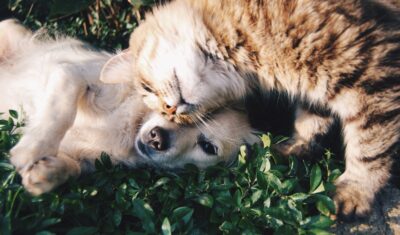By Kimberly Konopka, ’07, BS, AS, CVT, ESM
Originally published in the September 23, 2022, edition of the Valley Advantage
Did you know that the largest organ in cats and dogs is their skin and hair coat? It makes up close to 10 to 15% of their total body weight.
It is important for pet owners to help keep this organ in top shape because it is vital in performing many basic functions in keeping their pets healthy. These functions include:
Defense and Immunity — The skin and coat provide protection, acting as a shield to the internal organs from outside stressors such as chemicals, UV light or other environmental threats. The nerves within the skin also aid in sensing temperature variation, pain or pressure. Compromised skin health may lead to harmful bacteria causing diseases and infections.
Thermoregulation — Dogs and cats do not have sweat glands, so a healthy hair coat helps to maintain proper body temperatures and acts as an insulation layer. The movement of the hair follicles brings the hairs closer together to insulate against the cold, or the opposite allows air to move freely between the looser hairs to allow for a cooling effect.
Storage — The skin acts as a warehouse for storing several vital proteins, minerals, amino acids, enzymes, and collagen fibers. Many of these are necessary for cellular production and maintenance of those cells, along with various other functions.
So, how can you, a pet owner, contribute to skin and coat health?
The pet’s diet is the first influence on skin and coat health. As the saying goes, “you are what you eat,” and this also holds true for animals. Good quality pet food lays the foundation for proper pet health. These diets contain omega-3s, good sources of quality proteins, vitamins, and minerals, and provide the appropriate number of calories to meet the pet’s energy needs. To be sure you’re feeding your pet the right food, ask your veterinarian. Some pets do require additional supplements or have special dietary needs.
Proper grooming and bathing are also essential factors in maintaining healthy skin and coat. Some pets can’t or don’t groom themselves well and may need a little assistance keeping themselves less disheveled. Grooming your pet on a regular basis helps remove any dirt, debris, and dead skin cells.
As a pet owner, this is also an opportunity to closely examine your pet’s skin for abnormalities or parasites. The frequency of bathing will be dependent on the pet’s needs. Different hair coat types, such as heavy undercoats compared to the hairless varieties of dogs and cats, will have very different bathing schedules and shampoo requirements. Of course, the pet’s lifestyle will also influence bathing or grooming needs. Pets should only be bathed utilizing a shampoo formulated for the specific species. Pets are not small humans, and the pH of their skin varies significantly from ours. Human shampoos, including baby formula shampoo, should not be used on your pet as it is too harsh for their skin. If you are concerned about your pet’s hair coat, discuss the concern with your veterinarian, as there may be an underlying nutritional deficit or medical condition.
Ever wonder why your pet is so itchy?
There are many causes of itchy skin in pets, both external and internal. Unfortunately, it may be a very frustrating and time-consuming process to determine what is causing the condition.
External causes of acute or chronic itching include, but are not limited to, dry winter air or lack of humidity, environmental allergens such as grass or pollen from trees, or even an allergy to fleas or other biting insects.
Internal causes may include a food sensitivity/allergy or a systemic disease process.
Any of these concerns can cause skin problems such as hair loss, a greasy coat, excessive dandruff, rashes, odorous/dirty ears, or even open sores. Chronic itchy skin requires veterinary attention and generally serious detective work on the owner’s part. Keeping a journal of occurrences and possible triggers may help the veterinarian determine the cause. The veterinarian may arrive at a diagnosis and treatment quickly, but sometimes it may be very challenging and even require special care from a veterinary dermatologist. Occasionally, a food trial is necessary to eliminate a possible food allergy or sensitivity. Food trials require much effort and patience on the part of the pet owner, take a minimum of 90 days to complete and need a veterinary prescribed diet to be the only food source during this time.
Your pet’s skin and hair coat are a good indicator of their overall health. If the coat or skin becomes something other than smooth, shiny, and dandruff free, you may want to contact your veterinary care professional.
Kimberly Konopka, ’07, BS, AS, CVT, ESMT, is the program director of the Veterinary Nursing program at Johnson College. She has been in the field of veterinary medicine for 15 years.



